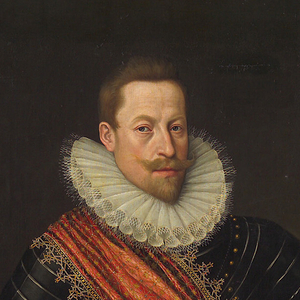
Emperor Matthias
*24.02.1557 Vienna - †20.03.1619 Vienna
Emperor of the Holy Roman Empire
Archduke of Austria
King of Hungary
King of Bohemia
Matthias, the son of Maximilian II. and Infanta Maria, grew up in Austria, unlike his two older brothers Rudolph and Ernst. His teachers included the scholar Ogier Ghislain de Busbecq (Busbekius). His father's tolerant religious attitude towards Protestants probably had a greater influence on Matthias than his mother's strict Catholicism. He was personally disappointed by the strict inheritance rules, according to which his brother Rudolph was to inherit the entire realm, while Maximilian II.'s other five sons were to be compensated with relatively modest annual allowances.
He failed in his first attempt at political action, the regency in the Netherlands from 1577 to 1582. In 1595, he became governor of Lower Austria. The conflict with his brother, Emperor Rudolph II., intensified and led to an open break in 1608.
Matthias gained power in Hungary, Austria above and below the Enns, and Moravia. He was elected King of Hungary and crowned King of Bohemia in 1611. His more conciliatory attitude towards the estates and confessional problems led to his election as emperor in 1612, after Rudolph's death. In 1618, the Thirty Years' War began with the Defenestration of Prague.
The marriage that Matthias entered into with his cousin Archduchess Anna in 1611 remained childless. He therefore appointed Archduke Ferdinand of Inner Austria as his successor.
In 1605, he had the Gatterburg (where Schönbrunn stands today), which had been destroyed by Bocskay's troops, rebuilt. After his exclamation, ‘Ei, welch ein schöner Brunnen’ (Oh, what a beautiful fountain), the later summer palace was given its name. The fountain stone shows a depressed crown with a cross and a double intertwined M. Matthias' motto Amat. Victoria. Cvram. is inscribed on the commemorative coin, which, together with four others, was buried in the ground when the foundation stone of the Capuchin Church was laid.
When Matthias died on the morning of 20 March 1619, the people were astonished that the death of the emperor had fulfilled Johannes Kepler's astrological prediction of the seven Ms for 1619: ‘Magnus Monarcha Mundi Medio Mense Martio Morietur’ – A great monarch of the world will die in the middle of March.
The heart and viscera urns of the founding couple, Empress Anna and Emperor Matthias, were initially buried in the Queen's Convent of St. Clare and, after the convent was dissolved by order of Josephs II., transferred to the heart crypt of the Augustinian Church and St. Stephen's Cathedral, respectively.

Der Sarkophag
Größe und Ausführung gleichen dem Sarkophag von Kaiserin Anna. Er ist jedoch zusätzlich mit dem durch die Kaiserkrone erhöhten Doppeladler versehen und mit einem Lorbeerkranz verziert. Das in vier Felder geteilte Plastron ist von der Kette des Ordens vom Goldenen Vlies umgeben. Das erste linke Feld zeigt die ungarischen Bänder, das zweite das österreichische Wappen (Querbalken) und die schiefgestellten burgundischen Balken. Das erste rechte Feld zeigt den böhmischen gekrönten Löwen, das zweite in vier Unterteilungen das kastilische Wappen und die leonischen Löwen. Auch hier wurden die Adlerfüße 1755 durch Balthazar Ferdinand Moll hinzugefügt.
Die Inschrift lautet:
D.O.M.S. MONUMENTUM AUGUSTISSIMI ET INVICTISS. CAESARIS MATTHIAE REGIS HUNGARIAE ET BOHEMIAE ARCHIDUCIS AUSTRIAE, QUI BEATO FINE VITAM ET IMPERIUM CONCLUSIT DIE XX MENSIS MARTII ANNO DOMINI MDCXIX.
Gott, dem Besten und Höchsten geweiht. Sarg des allerdurchlauchtigsten und unüberwindlichen Kaisers Matthias, Königs von Ungarn und Böhmen, Erzherzogs von Österreich, der mit einem seligen Ende das Leben und die Regierung beschloss, den 20. des Monats März, im Jahre des Herrn 1619.